The Ultimate Guide to Integrated Logistics Solutions for 2025
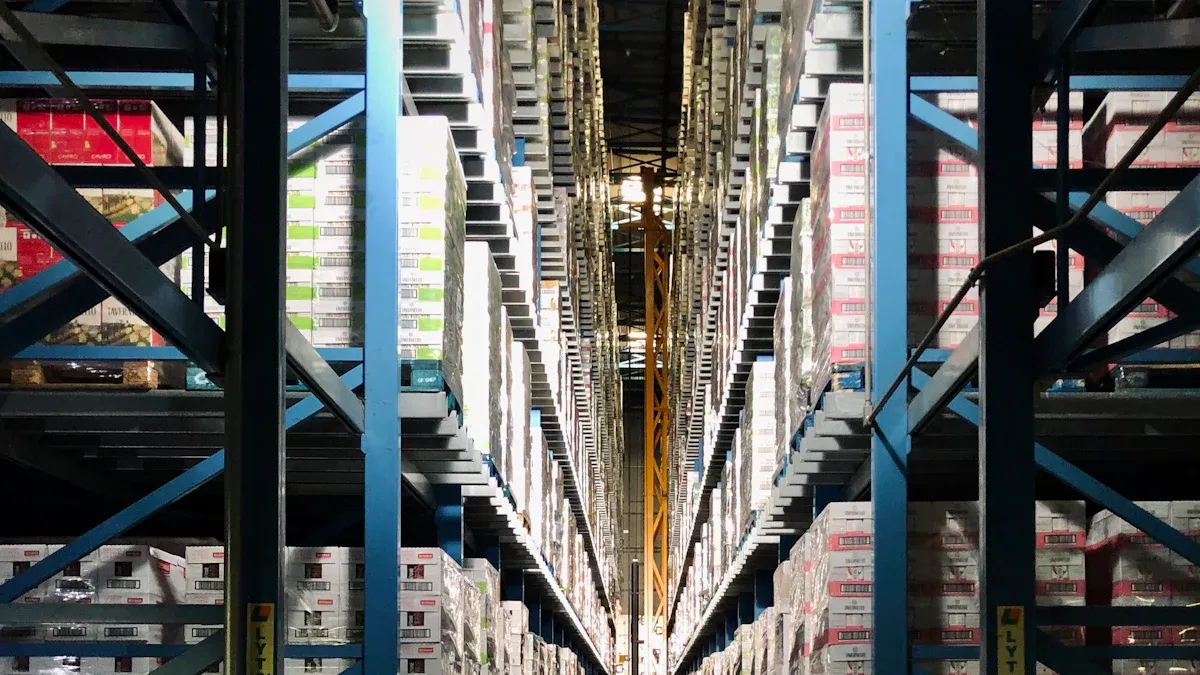
Integrated logistics solutions help companies handle transportation, warehousing, and information together. These are all managed in one system. The global market was USD 125,142.2 million in 2024. It is still growing very fast.
Region | Market Size (2024, USD million) | CAGR (2024-2031) |
|---|---|---|
North America | 50,056.88 | 14.2% |
Europe | 37,542.66 | 14.5% |
Asia Pacific | 28,782.71 | 18.0% |

Digitalization, automation, and AI are changing logistics. These tools make supply chain work faster and smarter. JUSDA is a leader in this change. They offer advanced logistics solutions for businesses around the world.
Key Takeaways
Integrated logistics solutions put transportation, warehousing, and information together in one system. This helps save time, lower costs, and make customer service better.
Using smart technology like AI, IoT, and cloud platforms lets companies watch goods in real time. It helps them plan better and react fast to changes.
JUSDA gives advanced logistics services that make things work better, support sustainability, and help businesses stay strong in a market that changes quickly.
Integrated Logistics Solutions Overview
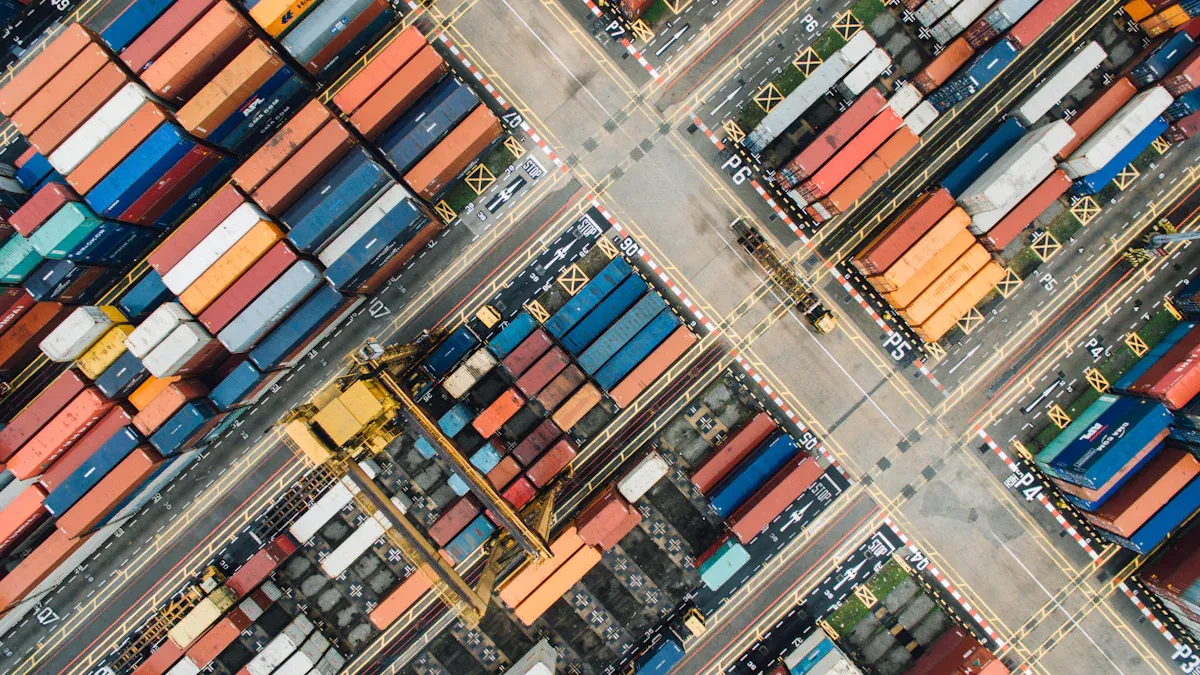
What Are Integrated Logistics Solutions
Integrated logistics solutions bring all logistics tasks together. Companies use technology to link transportation, warehousing, inventory, and orders. This way is different from older methods that keep things apart. Now, companies use systems like Warehouse Management Systems and Transportation Management Systems. These systems help automate jobs, watch inventory, and plan delivery routes.
The main parts of integrated logistics solutions are:
Using technology for automation and sharing data.
Managing inventory to keep the right amount in stock.
Processing orders quickly and correctly.
Warehousing and distribution with real-time tracking.
Managing transportation for on-time deliveries.
Connecting the supply chain to remove extra steps.
Planning in one place to use resources better.
Outsourcing work to third-party logistics providers.
Working together and talking with everyone involved.
This way helps companies share information fast. It helps them make quick choices and give better service to customers.
Why They Matter in 2025
Integrated logistics solutions are very important for businesses in 2025. Companies need to see their supply chain in real time. This helps them react fast when things change. Logistics solutions make work easier by cutting wait times and removing extra steps. Businesses save money by making things simple and using smart tracking systems.
Companies get happier customers with fast deliveries and clear updates.
Integrated logistics solutions also help companies grow and change easily. Businesses can handle busy seasons and new market needs. Smart tools like AI, IoT, and automation help manage risks and plan ahead. These benefits make integrated logistics solutions a must for companies that want to win in the global market.
Key Components of Logistics Solutions
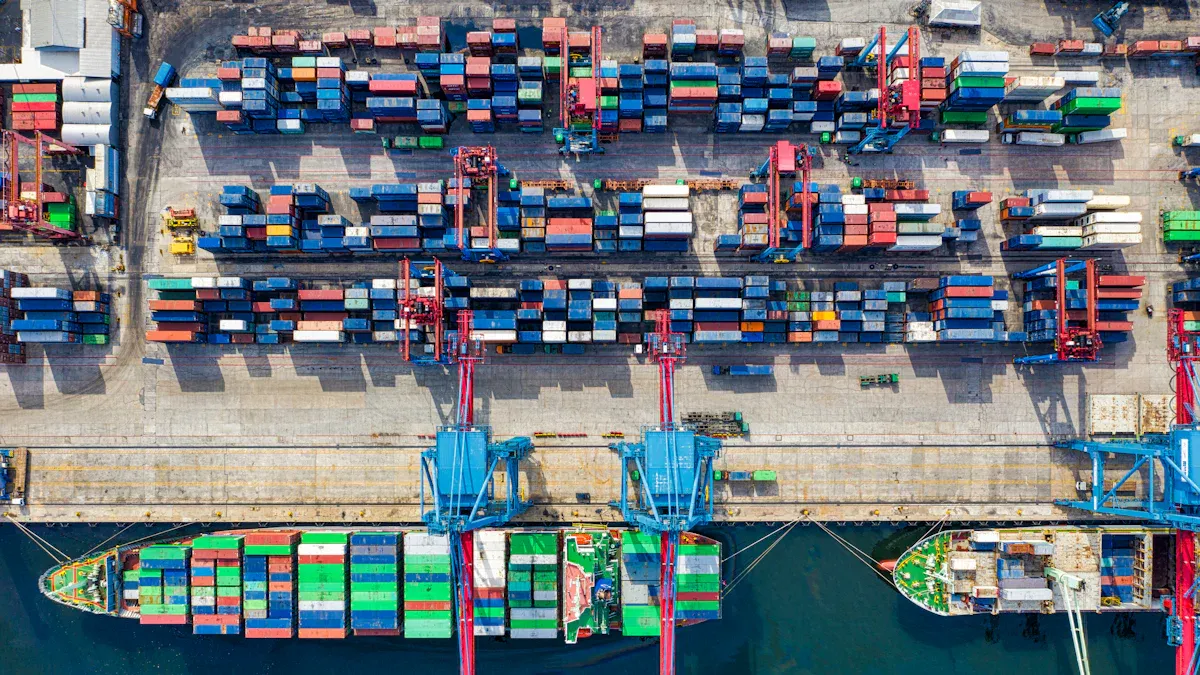
Transportation Modes
Transportation is very important in logistics. Companies use different ways to move goods. They use road, rail, sea, and air. Some companies mix these ways to save time and money. Rail-road and sea-road mixes are common in North America, Europe, and Asia-Pacific. These mixes help move lots of goods far away.
Transportation Mode Combination | Description/Region Focus | Volume (Billion Metric Tons, 2024) | Market Share / Percentage |
|---|---|---|---|
Rail-Road | North America, Europe | Part of 21.8 (two-mode transport) | Nearly 46% of multimodal in Asia and North America |
Sea-Road | Asia-Pacific | 9.1 (within two-mode transport) | Included in two-mode share |
Sea-Rail | Global | Included in 21.8 (two-mode) | Included in two-mode share |
Tri-modal (Sea-Rail-Road, Air-Road-Sea) | Global | 7.9 | Three-mode share globally |
Other Hybrid Modes | Specialized segments | 2.7 | Growing niche segments |
Roadways | Global | N/A | 43.3% in broader market |
Waterways | Global | N/A | CAGR 7.5% (2024-2030) |
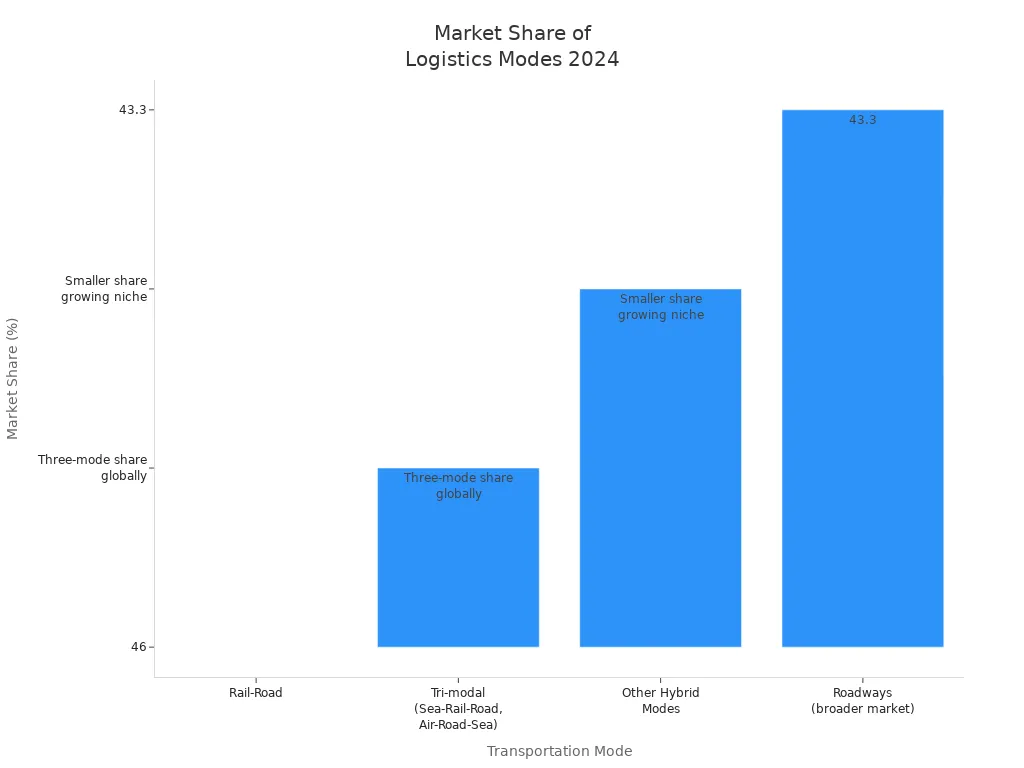
Logistics providers pick the best way to move goods. They think about how fast things need to go and how much it costs. For medical or car parts, companies use air or road for quick delivery. For big shipments, they use sea or rail because it is cheaper. This helps companies save money and keep customers happy.
JUSDA gives many transportation choices. They offer road, ocean, air, and rail. JUSDA uses special trucks for fragile or dangerous goods. They group cargo and plan smart routes to save money and time. JUSDA also helps with moving goods between countries. They serve electronics, cars, and new energy industries.
Warehousing and Inventory
Warehousing and inventory are very important in logistics. Modern warehouses use smart technology to store and move goods. Companies use automation, AI, and cloud systems to work faster and make fewer mistakes.
Some new things in warehousing and inventory are:
AGVs and AMRs move products safely and quickly.
WMS with AI tracks goods and predicts what is needed.
Sensors help fix machines before they break.
Eco-friendly packaging and energy-saving tools help the planet.
RFID and IoT give real-time inventory data.
Cobots work with people to get more done.
Cloud systems let companies see inventory from anywhere.
Using many warehouses helps deliver faster and costs less.
JUSDA’s cloud warehousing uses these smart tools. Their WMS tracks inventory live and uses AI to save space. JUSDA’s warehouses can be shared or just for one company. This helps companies handle busy times or grow bigger. JUSDA uses robots and smart forklifts to move goods faster and safer. They also care about the environment with green buildings and packaging.
JUSDA makes warehousing fit each industry. For electronics, they track many SKUs very closely. For cars, they use VMI to keep parts near factories. For fast-moving goods, JUSDA’s centers help deliver quickly and cut waiting time.
Cloud warehousing lets companies share data right away and work together, making logistics faster and easier to grow.
IT and Digital Integration
IT and digital tools help companies see and control their goods. Companies use IoT, AI, and cloud platforms to track, manage, and plan. These tools help stop delays and losses and help make better choices.
Modern logistics uses:
IoT devices to track goods everywhere.
Real-time data sharing to make things faster.
Connecting ERP, WMS, and TMS for smooth data flow.
Digital twins test supply chain plans.
Dashboards show how suppliers are doing.
Alerts and order tracking help customers.
Risk maps and KPIs help companies get better.
JUSDA’s JusLink platform brings all these tools together. It uses AI to watch the whole supply chain. The platform collects and studies data live. This helps companies make smart choices fast. JusLink connects suppliers, makers, and customers. It helps everyone work together better. AI helps plan and predict what is needed and what could go wrong. IoT and AI give live updates and tracking. This makes everything clear and quick. JusLink also helps track carbon and supports green logistics.
Feature/Capability | Description | Impact on Logistics Operations |
|---|---|---|
Integrates data, management, and algorithmic models across all supply chain segments | Enables comprehensive supply chain management from prediction to decision-making | |
Real-time Data Collection & Analysis | Collects and analyzes data in real time across suppliers, manufacturers, and customers | Facilitates timely, data-driven decisions improving operational agility |
Seamless Collaboration | Connects suppliers, manufacturers, and customers through shared insights | Optimizes coordination and efficiency in complex logistics environments |
AI-powered Planning & Predictive Analytics | Forecasts demand, inventory, and risk using AI | Enhances planning accuracy and risk management |
IoT and AI-powered Real-time Visibility | Provides live tracking and monitoring of supply chain activities | Improves transparency and responsiveness |
Sustainability & Green Logistics | Supports carbon tracking and promotes greener supply chains | Advances sustainability goals within logistics operations |
Hyper-Automation | Incorporates AMRs, drones, and AI-driven warehousing | Increases automation and operational efficiency |
JUSDA’s digital tools help with tough jobs. In North America, JUSDA uses VMI and centers for electronics and cars. In Vietnam, JUSDA manages over 20,000 SKUs for electronics. They use shared warehouses and connected transport. In India, JUSDA works with local supply chains and government to make warehousing and delivery better.
JUSDA’s eight main products—road, ocean, air, rail, cloud warehousing, consolidation, foreign trade, and JusLink—work together for smooth logistics. These products help companies move, store, and track goods and data, helping them grow and work better in every industry.
JUSDA Logistics Solutions: Benefits
Cost and Efficiency
JUSDA helps companies spend less and work faster. They connect transportation, warehousing, and inventory management. This makes the supply chain easier to manage. Companies get orders done quicker and make fewer mistakes. Teams use real-time tracking to find problems early. Automated systems help fix issues fast. Route planning tools help deliver goods quickly. Workflows are set up to make shipments more accurate.
Sharp is a global home appliance brand. Sharp worked with JUSDA to make its supply chain better. Sharp used JUSDA’s platform to lower logistics costs by 20%. They also made order processing faster. JUSDA’s cloud warehousing and JusLink platform give live updates. Companies see inventory and shipments right away. This helps avoid delays and keeps costs down.
JUSDA’s logistics solutions help companies use resources wisely, cut waste, and work better in every part of their business.
Customer Experience
JUSDA cares about what customers need most. Their logistics services focus on fast and accurate delivery. Customers get clear updates about their orders in real time. This helps build trust and keeps people happy.
Customers get their orders fast and on time. JUSDA uses smart tracking and flexible transport to meet deadlines.
Businesses can change delivery speed or route when needed. This helps during busy times or sudden changes.
JUSDA handles all logistics steps, so companies can focus on their main work.
Companies can offer same-day or next-day delivery. This meets shoppers’ high expectations.
End-to-end visibility helps keep prices low and cut waste.
A survey by IBM in 2021 found that 60% of CEOs care most about customer experience. JUSDA’s integrated logistics help companies meet these needs. Their solutions connect every part of the supply chain. This makes deliveries more reliable and keeps customers satisfied.
“JUSDA’s platform gave us full control and visibility. Our customers saw faster service and better speed.” — Sharp Supply Chain Manager
Competitive Edge
JUSDA helps companies stay ahead in the market. Their integrated logistics lower risks and help businesses react quickly. JUSDA brings together suppliers, transport, and warehousing. This cuts down on communication problems and delays. Companies can handle sudden demand or supply chain issues easily.
JUSDA’s digital tools use AI and real-time analytics. These help companies plan for the future. They can predict risks and test new ideas. Companies work closely with partners to stay flexible. Survey data shows 69% of companies see economic benefits from integrated logistics. 58% notice less risk and 54% have a better reputation.
JUSDA’s flexible services include integrated distribution centers. These help businesses handle extra shipments and deliver faster. This keeps companies ahead of others.
Sustainability
JUSDA supports green logistics to help the planet. Their solutions help companies lower carbon emissions. They use route optimization software to save fuel and cut emissions. JUSDA invests in electric and hybrid vehicles for cleaner transport. Their warehouses use solar panels, smart lights, and energy-saving systems.
JUSDA uses eco-friendly packaging and asks suppliers to do the same.
AI and IoT tools track energy use and find ways to save.
Carbon tracking software helps companies set and reach emissions goals.
Data analytics spot waste and improve fuel efficiency.
JUSDA’s focus on sustainability helps companies follow rules and build a strong brand. Their logistics solutions balance cost, performance, and care for the environment.
JUSDA’s green practices make logistics better for the planet and for business.
Implementing Integrated Logistics Solutions
Assessment and Planning
Companies start by looking at what they need for logistics. They decide which jobs to outsource. They think about order numbers, where goods go, and how fast inventory moves. Next, they look for providers with good skills and services. Businesses ask for detailed offers from these providers. They compare costs, service, flexibility, and technology. After picking the best provider, teams make a plan together. The plan shows who does what and when. It lists important goals and KPIs. Employees get training to learn new systems. Regular checks and feedback help things get better all the time.
Steps for Assessment and Planning:
Find out what logistics needs and outsourcing choices there are.
Look up and pick providers to consider.
Ask for offers and check them.
Pick the provider that fits best.
Make a clear plan for starting.
Teach employees about new systems.
Check how things go and get feedback.
Piloting and Testing
Businesses often begin with a pilot program. They pick one product or area to test solutions. Teams set simple goals like faster delivery or lower costs. They choose KPIs such as order fill rates and on-time delivery. Scorecards and dashboards help track these numbers. Teams look at results and change things if needed. Pilots show what works and help companies feel ready for bigger changes.
KPI Name | Description |
|---|---|
On-time performance | How many orders arrive on time |
Order accuracy | Right products and amounts sent |
Inventory accuracy | Inventory records match real stock |
Labor productivity | How much work gets done per hour |
Asset utilization | Trucks, warehouses, and workers used well |
Warehouse space utilization | How much warehouse space is used |
Collaboration and Support
Good teamwork helps logistics work well. Teams share data and ideas right away. This helps them make better choices. Solving problems early stops big delays. Departments work together to plan and manage inventory. Working with third-party providers like JUSDA gives expert help. Their advice helps companies learn new tech and handle global supply chain problems. Cloud platforms and dashboards make talking and risk control easy. Ongoing help keeps things running smoothly and always improving.
Tip: Strong teamwork and expert help let companies change fast and reach long-term logistics goals.
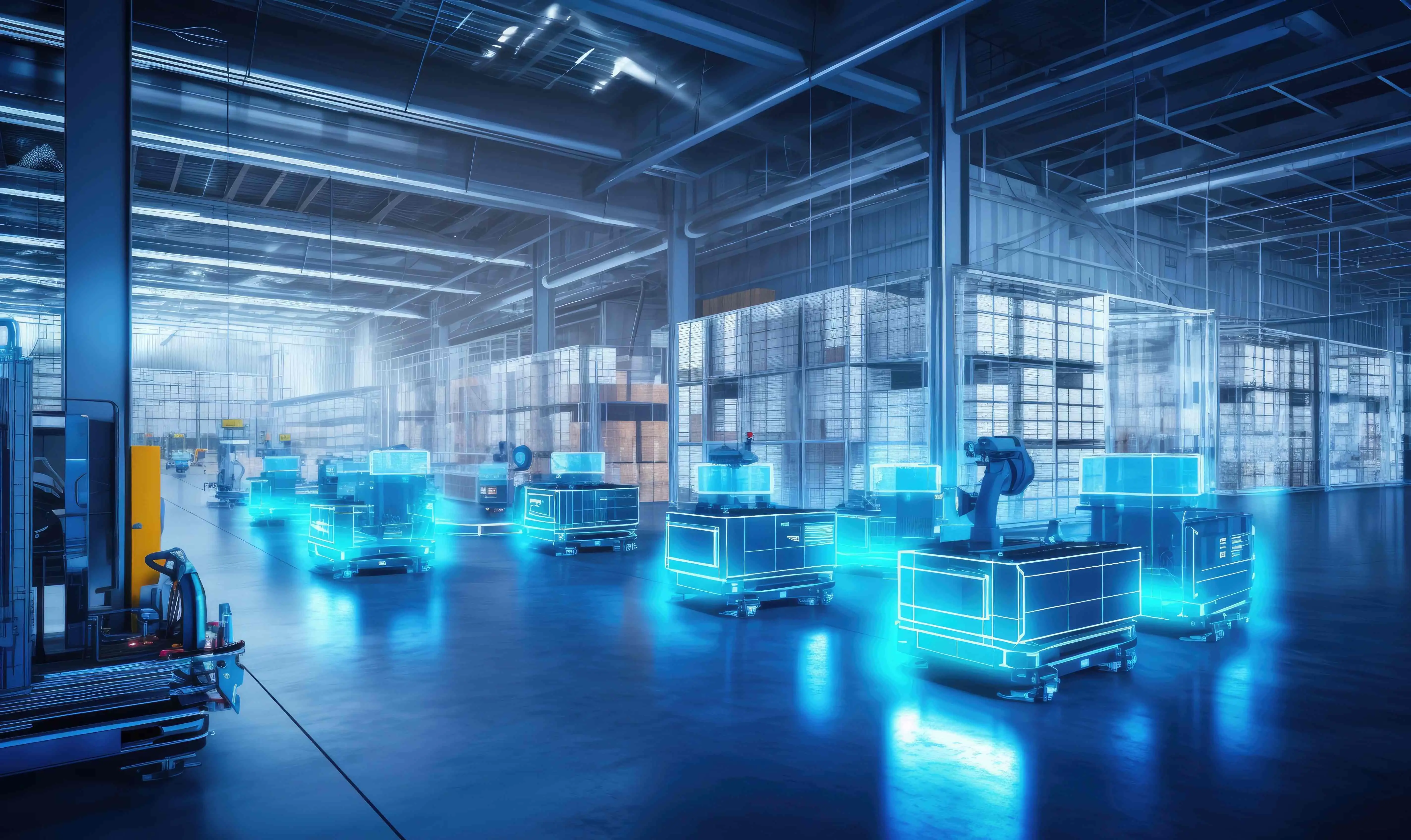
JUSDA Solutions
To provide you with professional solutions and quotations.
Integrated logistics solutions help businesses grow by making fewer mistakes and helping teams work better together. They let companies use data right away. This saves money and makes customers happier. JUSDA is a top company because it uses smart technology and works all over the world. Companies that try new ideas and use digital tools will have strong supply chains that are ready for the future.
Better planning means less waiting and fewer mistakes.
Using live data helps keep track of inventory.
Good teamwork makes logistics work better.
Fast deliveries make customers want to come back.
Digital tools help companies be green and quick.
See Also
Mastering Manufacturing Success In 2024 Through Supply Chain
Comprehensive Insights Into Eco-Friendly Supply Chain Transportation
How Artificial Intelligence Is Transforming Future Supply Chains
Inside Look At Leading Worldwide Logistics Firms Today
Optimizing Lean Logistics To Boost High-Tech Manufacturing Results
